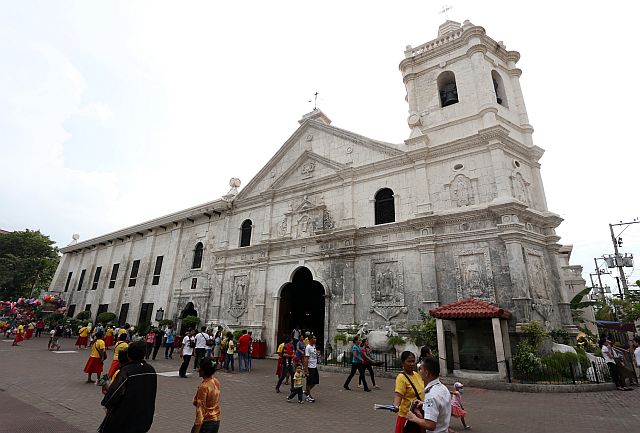
The bells will toll for three minutes early tomorrow morning at the newly reconstructed centuries-old bell tower of the Basilica Minore del Santo Niño to commemorate the third anniversary of the Oct. 15, 2013 earthquake.
(CDN PHOTO/JUNJIE MENDOZA)
Life has edged back to normal at the Basilica Minore del Sto. Niño, Cebu’s oldest church.
Three years after a 7.2 magnitude earthquake crushed its centuries-old bell tower on October 15, 2013, the bells, which were restored early this year, will peal for three minutes.
The bells at the newly reconstructed bell tower will ring at 5:30 a.m., thirty minutes before the first of four Saturday Masses begins, said Fr. Pacifico “Jun” Nohara, OSA, rector of the basilica.
“This is our way of remembering the devastating earthquake,” Nohara told Cebu Daily News of the tremor that shook Cebu and brought neighboring Bohol province to its knees.
Aside from ringing the bells early tomorrow morning, the Augustinian fathers at the basilica will also dedicate all their Masses today for the souls of those who perished in the quake and for people who have yet to recover from the devastation.
At least 200 people died in the strongest quake to hit Cebu and Bohol in recent years.
Back to normal
While the bell tower had been restored to its original design, beautification works, however, still continue to further improve the basilica in preparation for the 500th anniversary of the Christianization of the Philippines in 2021.
Nohara said he wanted to implement a number of projects to make visits at the basilica more comfortable.
“I just want to return the favor (to the people). They have helped us a lot. And I want them to know that the donations they give don’t go to the priests but are intended for several projects of the community,” the rector said.
A major concern at the basilica, Nohara said, was on how to address flooding at the church grounds every time the rains poured.
He said they decided to construct a cistern or a structure underneath where floodwater goes.
The 43-year-old rector said he also wanted to replace the existing roof of the basilica and the nearby convent after a heavy downpour last July destroyed paintings on the church’s ceilings near the main entrance, beneath the choir loft.
The rains also damaged the basilica’s sound system and drenched the choir loft that houses a pipe organ.
“It was after that incident when I really prayed hard before the image of the Sto. Niño, and even told Him I want to give up. Amid all the problems, I asked the Lord to help me,” said Nohara, adding that being a rector of the basilica is no easy task.
Nohara, who assumed the post last May 19, led the repainting of the bleachers and the altar at the Pilgrim Center where open air masses and other activities are held.
He also ordered the renovation of all comfort rooms at the basilica.
“As much as possible, I want to address the concerns of the people. That’s really one of my priorities. I want them to feel comfortable,” he said.
Nohara earlier sought the assistance of the National Historical Commission of the Philippines (NHCP) which facilitated the renovation of the bell tower.
However, he was told that there was not enough budget to finance other projects at the basilica.
“We have to look for our own source of funds. Budget is a concern right now. But I am not worried. I know the Sto. Niño will provide,” said Nohara, a native of Pilar town, Camotes Island in northern Cebu.
“I’m just happy that the bell tower was restored before I assumed as rector. The basilica reminds us of where Christianity (in the Philippines and in the Far East) started. Let’s give importance to it,” Nohara said.
The project for the restoration of the bell tower was awarded to 401 Development and Construction Corp. in the middle of 2015. Construction work was completed after six months.
Last March, the NHCP, which supervised the restoration, turned over the newly constructed bell tower, the basilica, and the adjacent Magellan’s Cross which also underwent repair to the Augustinian priests.
Then president Benigno Aquino III attended the event.
The government spent P14 million for the restoration of the bell tower and P3 million for the Magellan’s Cross kiosks.
The basilica is the home of the wooden image of the Sto. Niño which was given as a baptismal gift by Portuguese explorer Ferdinand Magellan to Cebu’s Queen Juana in 1521.
The image of the Child Jesus, which is venerated inside the church, is the country’s oldest icon.
Beside the basilica is a kiosk that houses the cross planted by Magellan as a symbol of the Christianization of the Philippines.
Nohara said some coral stones from the original bell tower that were not used in the existing structure will later be used to construct landmarks at the Sto. Niño Spirituality Center in Consolacion, Cebu City.

